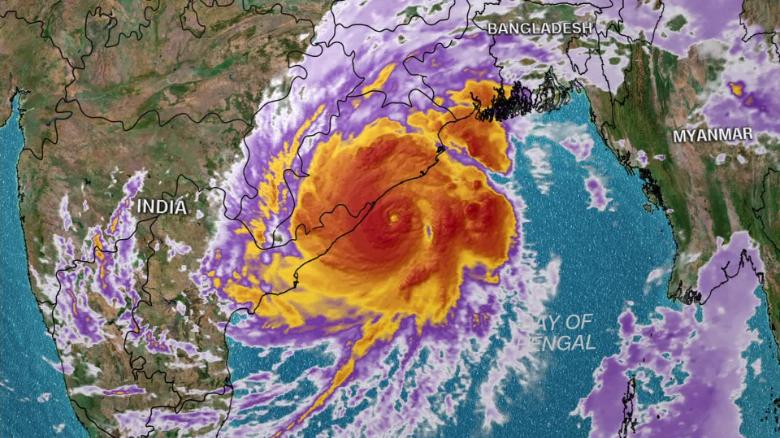Surviving a Tropical Cyclone
"This [Cyclone Fani] is not as bad [as the 1999 super cyclone]."
"Apart from these winds which may cause damage in terms of uprooting small trees in West Bangal and some big trees in Odisha and extensive damage to thatched houses and mud houses ... [and] disruption of power and telecommunication lines, it can also impact the rail and road traffic and also air traffic for some time."
Mrutyunjay Mohapatra, Meteorological Department scientist, India
"In the event of such a major calamity like this — where Odisha was hit by close to a super-cyclone — instead of being a tragedy of humongous proportion, we are in the process of restoring critical infrastructure."
"That is the transformation that Odisha has had."
Naveen Patnaik, Odisha state top government official

The description of the potential damage that a cyclone with lashing rain and winds gusting up to 205 km/h can impact on a geographical area sounds fearful enough in its damaging action on peoples' homes and civic infrastructure to send shivers up and down the spine of people fortunate enough to live in areas of the globe geographically distant from such tropical storm systems. The reality of the damage that the cyclone did inflict on the coastal state of Odisha was sufficiently fearful, withal.
The desert state of Rajasthan bordering Pakistan was impacted by huge dust storms, while on the Arabian Sea the coastal state of Maharashtra saw heat waves and elsewhere bordering China, heavy rains descended, reaching to the Himalayas where the rain fell in the frozen state of mountainous snowfalls. Fani represented the second-most severe of cyclones in India's meteorological measurements, equivalent to a Category 3 hurricane.
"[It is a] very, very scary feeling", Tanmay Das, 40, a resident of Bhubaneswar, a city in Odisha said, describing "the sound of wind as if it will blow you away". Violent enough to whip palm trees like flexible rubber mops against almost-opaque rain-gusting skies. The thatched-roof houses in the area were all destroyed. Electricity was cut off. Electricity poles were down, alongside fallen trees.
 |
| A marooned elderly couple sit on a log close to their home surrounded by high waters in Khulna, Bangladesh on Saturday. (Munir uz Zaman/AFP/Getty Images) |
Rail lines were closed, the Kolkata airport was closed, and an estimated 200 trains across India saw cancellation as the storm hit in the midst of India's six-week general election, forcing cancellation of political campaign events around Kolkata as the cyclone in the Bay of Bengal hit, impacting weather across the Asian subcontinent.
As astonishing 1.2 million people were evacuated from Odisha's low-lying areas, moved to an equally amazing four thousand shelters, a plan carried out by India's National Disaster Response Force. The Indian navy, air force, army and coast guard were placed on high alert. This was a first for India, an unprecedented evacuation of immense proportions. Friday afternoon saw the cyclone downgraded t a "very severe" storm.
 |
| Neighbours show damage caused by Cyclone Fani in the Penthakata fishing village of Puri, in the eastern Indian state of Orissa on Saturday. (Associated Press) |
There was a dispatch of 54 rescue and relief teams of doctors, engineers and deep-sea divers to areas along the coast prone to flooding, as far afield as Andaman and Nicobar Islands in the Bay of Bengal; the work of the National Disaster Response Force. Sri Lanka, off the eastern tip of India was expecting up to four inches of rain.
On Mount Everest, mountaineers and Sherpa guides descended to lower camps to wait out the worsening weather after a warning was issued that heavy snowfall was expected at higher elevations. Trekking agencies were required to take tourists to safety, so hundreds of climbers, guides, cooks and porters took haven from the weather raging about them, leading to poor visibility, at the Everest base camp.
 |
| A family crosses the Buriganga River by boat during rainy weather in Dhaka, Bangladesh on Saturday. (Monirul Alam/EPA-EFE) |
The 1999 "super" cyclone in the Bay of Bengal killed roughly ten thousand people, devastating large areas of Odisha. More reliable forecasts and improved disaster management coordinating saw a vastly better outcome. The 2013 Cyclone Phailin led to the deaths of fewer than fifty people, in contrast to the wind speeds of 260 to 280 km/hr in 1999 that took such a huge death toll.
This time, there were fifteen deaths, and an unknown number of injuries, considerably smaller in numbers reported, thanks to the monumental task of moving 1.2 million people to temporary haven and safety from the initial grade 5 storm that was cyclone Fani. Now, it is the turn of Bangladesh where already a dozen people are reported to have been killed by the effects of the downgraded "severe storm".
Labels: Bangladesh, Cyclone, India, Natural Disasters, Weather

<< Home